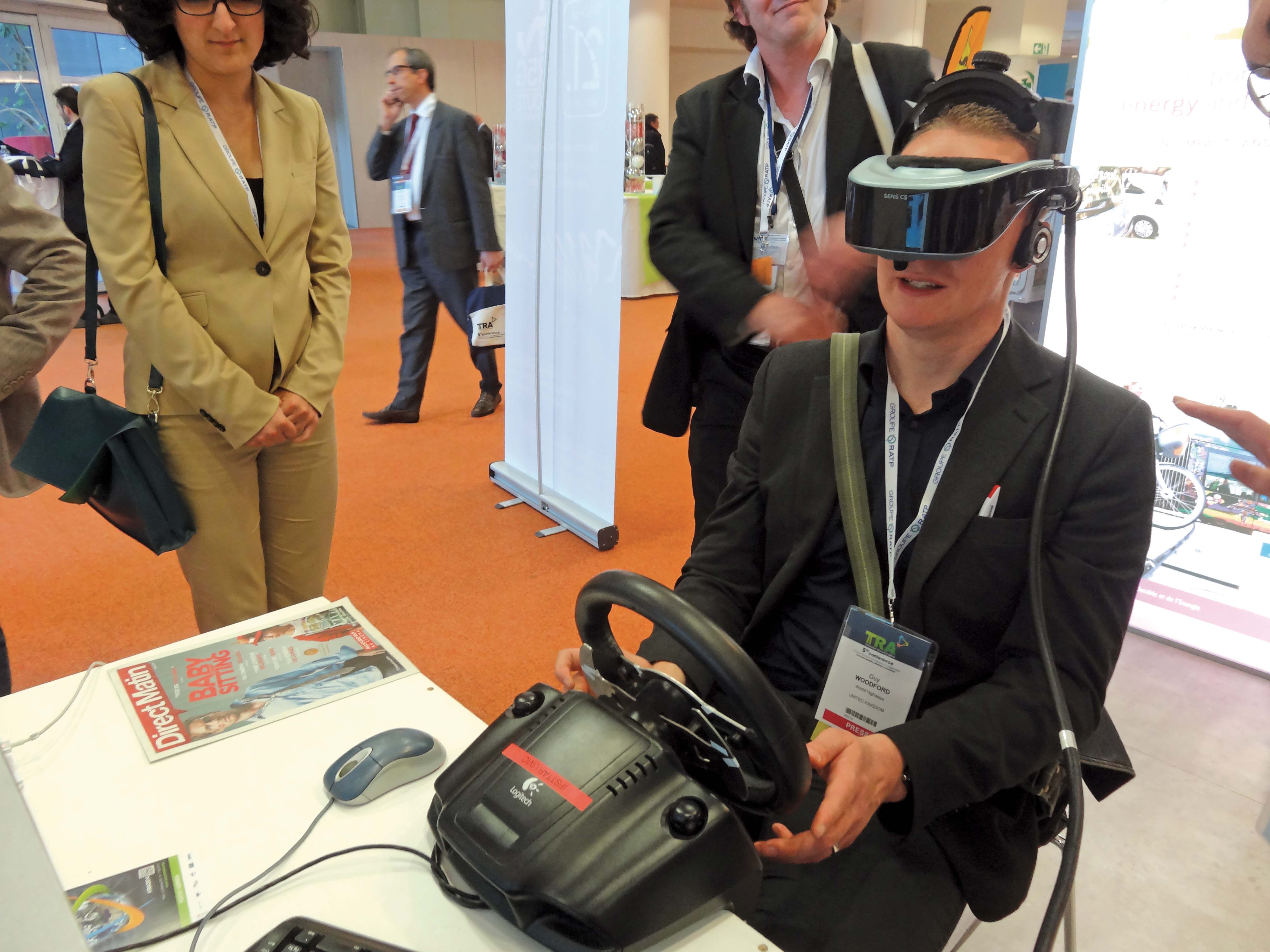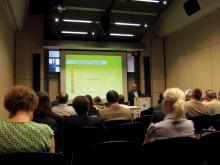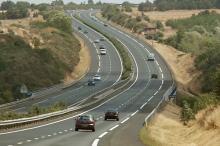Despite tight finances due to the current global economic climate, the recent Transport Research Arena (TRA) 2014 show in Paris showed how innovative transport research, largely using cutting-edge ITS, is creating safer and smarter highways of the future. Guy Woodford reports How far can you drive around a car race track with no other vehicles on it on half a glass of fuel while attempting to maintain a speed of 60kph? After taking up the challenge offered by the Eco Driving Simulator using SiVIC (Simulatio

World Highway’s Guy Woodford tries out the driving simulator technology
Despite tight finances due to the current global economic climate, the recent Transport Research Arena (TRA) 2014 show in Paris showed how innovative transport research, largely using cutting-edge ITS, is creating safer and smarter highways of the future. Guy Woodford reports
How far can you drive around a car RACE track with no other vehicles on it on half a glass of fuel while attempting to maintain a speed of 60kph? After taking up the challenge offered by the Eco Driving Simulator using SiVIC (Simulation of Vehicle Infrastructure and Sensors) software at TRA2014 in Paris, I managed to drive for 1,400 metres before coming to a halt. Apparently this wasn’t a bad effort, as 1,700 metres had been the record distance recorded to that point by the IFSTTAR research team behind the Simulator aimed at illustrating the link between fuel consumption and consistent driving speed.
“We want to use this to train drivers to use their vehicle’s fuel more efficiently by driving within a speed limit. It also helps to teach respect for driving conditions,” said Dr Olivier Orfila, lead researcher on the Eco Driving Simulator project, who is based at IFSTTAR’s LIVIC laboratory in Versailles, near Paris.
The virtual reality helmet placed on my head felt quite heavy to wear. Its two simulated cameras, one for each eye, send pictures to the helmet creating a 3D effect for the virtual reality car RACE track, complete with fairly Sharp bends, I was driving on. Around 500 people have tried the simulator since its launch by IFSTTAR, the TRA2014 organising body, at the Paris Science Festival two years’ ago.
The IFSTTAR Eco Driving Simulator was among a number of eye-catching interactive tools and displays at the 5th edition of TRA, Europe’s largest conference on transport research and innovation, held at CNIT in Paris 14-17 April 2014. This year’s event set a new345 TRA show attendance record – drawing nearly 3,000 visitors from 56 countries.
Over 130 sessions, 650 presentations, 15 associated events and 1,000m² of exhibitions welcomed researchers and industrial and public policy professionals. They gathered to examine their ideas about society’s changing transport usage and needs in the face of mounting energy and environmental challenges.
Keynote speakers during TRA2014 were Shane Sutherland, member of the cabinet of Máire Geoghegan-Quinn, European Commissioner for Research, Science and Innovation, who stood in for her and highlighted the €80 billion Horizon 2020 initiative - the biggest EU Research and Innovation programme ever - and how it aims at tackling transport issues; and José Viegas, Secretary General of ITF (1102 International Transport Forum) at the OECD, who discussed the challenges faced by transport and how efficient transport systems and infrastructure contribute to realising society’s overall ambitions.
The Forum of European National Highway Research Laboratories (FEHRL) and its extensive member network were heavily represented at the four-day event. TRA 2014 delegates learned about how FEHRL has created the Forever Open Road (FOR), which it describes as a revolutionary concept on how the best highway infrastructure research today can be coupled with the best of what is due to come in future years to create the 5th Generation Road: a road that is adaptable, automated and climate change resilient based on a concept that can be applied to building and maintaining roads, whether they be motorways, rural or urban roads, and regardless of region or country.
Having completed the FOR concept development in 2010, scoped its research and development in 2011, and completed the adaptable, climate change resilient and automated road elements of FOR in 2013, the5160 FEHRL team behind FOR are now entering a key fourth phase: the delivery of linked research and demonstration projects.
Given the exciting research now underway within FOR, new FEHRL and German Federal Highway Research Institute (BASt) President Stefan Strick and new FEHRL Secretary General Thierry Goger were keen to highlight the programme during TRA2014, along with other ongoing transport research work and campaigns taking place under the FEHRL banner.
“First of all we have to face the challenges for road infrastructure, including the impact of climate change, within the budget crisis. Forever Open Road will give answers to these problems. We need a special surface on the road; we need a silent road; and we also need good maintenance and durability. These challenges are challenges for all members of FEHRL and we need to co-operate,” said Strick during the event.
In November 2014, FEHRL will celebrate its 25th anniversary. Of this approaching landmark, Strick said, “The road authorities of the EU member states see the need for FEHRL, and FEHRL has showed them that there will be a better situation for them if common research is done. That is real success.”
Also speaking during TRA2014, Goger said, “The main idea of FOR is to try and get roads with imbedded technologies inside that can shift from a regular periodic maintenance Plan to a more tailor-made Plan: to do maintenance only when you need it. This can be helped by using materials that have a longer lifetime.
“More and more we are looking at the environment. How can we use alternative energy? How can we embed, for instance, solar panel and wind turbine-generated energy in the road infrastructure? How can we develop inductive technology, so that when you are driving your electric car or when you’ve parked it, it’s going to be recharging?
“FEHRL is looking at roads for road users. We are thinking ahead.”
Dr Lutz Pinkofsky, also of1369 BASt, which has a near €50 million annual budget, says the FEHRL member research institute spends around €20 million on new research each year. Of BASt’s current research priorities, he says, “The big issue is to help the [German Transport and Digital Infrastructure] Ministry on a research level to support its daily business, to help the Ministry with its harmonisation and standardisation [transport network and regulation] questions, and to help to bring innovation on the roads. We work on nearly 100 bigger research projects every year.”
Infravation, the trans-nationally funded road infrastructure research programme, was also much discussed at TRA2014. Peter Wilbers, Infravation ERA NET Plus Coordinator and Senior Programme Consultant at Rijkswaterstaat, part of the Dutch Ministry of Infrastructure and the Environment, was busy promoting the Infravation 2014 Call, launched on 3 March 2014, during the event.
The Infravation 2014 Call is pooling around €9 million of funding, partly from the European Commission, and for the first time, the US Federal Highway Administration (FHWA) is contributing funding to an ERA NET Plus Call. This is seen as a major development that will prompt greater information and research sharing internationally. Through the Call will see road infrastructure innovation research undertaken by a collaboration of researchers from a great many countries. Through the Call is a pooled fund of 11 EU members and associated countries and the USA. Researchers from non-funding EU member and associated countries can also participate and get funding. This is said to be another of the Call’s unique features.
Key research topics specified in a Scoping Study for the Infravation 2014 Call include advanced predictive infrastructure performance processes, enhanced durability and lifetime extension, and rapid and non-destructive methods for routine quality and performance checks of materials and construction. Light proposals must be submitted by 30 June 2014. Consortia of favourably evaluated light proposals will then be invited to submit full proposals by the end of November 2014. Following a strict international peer review, selected full proposals will be invited for negotiations. Research projects are expected to start by the middle of 2015.
Wilbers said, “I think we might be getting 50 to 60 proposals, achieving double the number we estimated. I put this number down to a combination of things. I think it’s a rather easily accessible funding scheme, there’s been good dissemination of information [on the Infravation 2014 Call], and the [research] topics listed in the Call are priorities for road infrastructure research.
“The more good quality proposals we get, the better the end result will fit the needs of roads’ directorates. We clearly stated in the Guide for Applicants that it’s important that their research results are really tangible and can be used directly to improve road infrastructure.”
TRA2014 ended with the baton being passed to Poland, with the country’s capital Warsaw due to host the subsequent edition in 2016.
Dr Andrzej Urbanik, General Secretary of the Polish Road Transport Technology Platform, who was at TRA2014 partly to promote Poland’s hosting of the 2016 event, said, “I think the 2016 event will be a good starting point to show the state-of-the-art research in surface transport outside the European Union or the Trans-Atlantic dimension.
“At the Road and Bridge Research Institute, I’m working mostly in ITS. For example, we’re doing a very interesting project on Weigh in Motion. We also do a lot with Traffic Speed Deflectometers, to give us a lot of information about the whole state of the road. This can be of very good use to pavement management programmes.”
A summary of the scientific findings from TRA2014, along with principal directions that can be drawn from them to assist with planning public transport policy, were due to be presented at the European Mobility Exhibition in Paris from 10 to 12 June 2014.
How far can you drive around a car RACE track with no other vehicles on it on half a glass of fuel while attempting to maintain a speed of 60kph? After taking up the challenge offered by the Eco Driving Simulator using SiVIC (Simulation of Vehicle Infrastructure and Sensors) software at TRA2014 in Paris, I managed to drive for 1,400 metres before coming to a halt. Apparently this wasn’t a bad effort, as 1,700 metres had been the record distance recorded to that point by the IFSTTAR research team behind the Simulator aimed at illustrating the link between fuel consumption and consistent driving speed.
“We want to use this to train drivers to use their vehicle’s fuel more efficiently by driving within a speed limit. It also helps to teach respect for driving conditions,” said Dr Olivier Orfila, lead researcher on the Eco Driving Simulator project, who is based at IFSTTAR’s LIVIC laboratory in Versailles, near Paris.
The virtual reality helmet placed on my head felt quite heavy to wear. Its two simulated cameras, one for each eye, send pictures to the helmet creating a 3D effect for the virtual reality car RACE track, complete with fairly Sharp bends, I was driving on. Around 500 people have tried the simulator since its launch by IFSTTAR, the TRA2014 organising body, at the Paris Science Festival two years’ ago.
The IFSTTAR Eco Driving Simulator was among a number of eye-catching interactive tools and displays at the 5th edition of TRA, Europe’s largest conference on transport research and innovation, held at CNIT in Paris 14-17 April 2014. This year’s event set a new
Over 130 sessions, 650 presentations, 15 associated events and 1,000m² of exhibitions welcomed researchers and industrial and public policy professionals. They gathered to examine their ideas about society’s changing transport usage and needs in the face of mounting energy and environmental challenges.
Keynote speakers during TRA2014 were Shane Sutherland, member of the cabinet of Máire Geoghegan-Quinn, European Commissioner for Research, Science and Innovation, who stood in for her and highlighted the €80 billion Horizon 2020 initiative - the biggest EU Research and Innovation programme ever - and how it aims at tackling transport issues; and José Viegas, Secretary General of ITF (
The Forum of European National Highway Research Laboratories (FEHRL) and its extensive member network were heavily represented at the four-day event. TRA 2014 delegates learned about how FEHRL has created the Forever Open Road (FOR), which it describes as a revolutionary concept on how the best highway infrastructure research today can be coupled with the best of what is due to come in future years to create the 5th Generation Road: a road that is adaptable, automated and climate change resilient based on a concept that can be applied to building and maintaining roads, whether they be motorways, rural or urban roads, and regardless of region or country.
Having completed the FOR concept development in 2010, scoped its research and development in 2011, and completed the adaptable, climate change resilient and automated road elements of FOR in 2013, the
Given the exciting research now underway within FOR, new FEHRL and German Federal Highway Research Institute (BASt) President Stefan Strick and new FEHRL Secretary General Thierry Goger were keen to highlight the programme during TRA2014, along with other ongoing transport research work and campaigns taking place under the FEHRL banner.
“First of all we have to face the challenges for road infrastructure, including the impact of climate change, within the budget crisis. Forever Open Road will give answers to these problems. We need a special surface on the road; we need a silent road; and we also need good maintenance and durability. These challenges are challenges for all members of FEHRL and we need to co-operate,” said Strick during the event.
In November 2014, FEHRL will celebrate its 25th anniversary. Of this approaching landmark, Strick said, “The road authorities of the EU member states see the need for FEHRL, and FEHRL has showed them that there will be a better situation for them if common research is done. That is real success.”
Also speaking during TRA2014, Goger said, “The main idea of FOR is to try and get roads with imbedded technologies inside that can shift from a regular periodic maintenance Plan to a more tailor-made Plan: to do maintenance only when you need it. This can be helped by using materials that have a longer lifetime.
“More and more we are looking at the environment. How can we use alternative energy? How can we embed, for instance, solar panel and wind turbine-generated energy in the road infrastructure? How can we develop inductive technology, so that when you are driving your electric car or when you’ve parked it, it’s going to be recharging?
“FEHRL is looking at roads for road users. We are thinking ahead.”
Dr Lutz Pinkofsky, also of
Infravation, the trans-nationally funded road infrastructure research programme, was also much discussed at TRA2014. Peter Wilbers, Infravation ERA NET Plus Coordinator and Senior Programme Consultant at Rijkswaterstaat, part of the Dutch Ministry of Infrastructure and the Environment, was busy promoting the Infravation 2014 Call, launched on 3 March 2014, during the event.
The Infravation 2014 Call is pooling around €9 million of funding, partly from the European Commission, and for the first time, the US Federal Highway Administration (FHWA) is contributing funding to an ERA NET Plus Call. This is seen as a major development that will prompt greater information and research sharing internationally. Through the Call will see road infrastructure innovation research undertaken by a collaboration of researchers from a great many countries. Through the Call is a pooled fund of 11 EU members and associated countries and the USA. Researchers from non-funding EU member and associated countries can also participate and get funding. This is said to be another of the Call’s unique features.
Key research topics specified in a Scoping Study for the Infravation 2014 Call include advanced predictive infrastructure performance processes, enhanced durability and lifetime extension, and rapid and non-destructive methods for routine quality and performance checks of materials and construction. Light proposals must be submitted by 30 June 2014. Consortia of favourably evaluated light proposals will then be invited to submit full proposals by the end of November 2014. Following a strict international peer review, selected full proposals will be invited for negotiations. Research projects are expected to start by the middle of 2015.
Wilbers said, “I think we might be getting 50 to 60 proposals, achieving double the number we estimated. I put this number down to a combination of things. I think it’s a rather easily accessible funding scheme, there’s been good dissemination of information [on the Infravation 2014 Call], and the [research] topics listed in the Call are priorities for road infrastructure research.
“The more good quality proposals we get, the better the end result will fit the needs of roads’ directorates. We clearly stated in the Guide for Applicants that it’s important that their research results are really tangible and can be used directly to improve road infrastructure.”
TRA2014 ended with the baton being passed to Poland, with the country’s capital Warsaw due to host the subsequent edition in 2016.
Dr Andrzej Urbanik, General Secretary of the Polish Road Transport Technology Platform, who was at TRA2014 partly to promote Poland’s hosting of the 2016 event, said, “I think the 2016 event will be a good starting point to show the state-of-the-art research in surface transport outside the European Union or the Trans-Atlantic dimension.
“At the Road and Bridge Research Institute, I’m working mostly in ITS. For example, we’re doing a very interesting project on Weigh in Motion. We also do a lot with Traffic Speed Deflectometers, to give us a lot of information about the whole state of the road. This can be of very good use to pavement management programmes.”
A summary of the scientific findings from TRA2014, along with principal directions that can be drawn from them to assist with planning public transport policy, were due to be presented at the European Mobility Exhibition in Paris from 10 to 12 June 2014.







